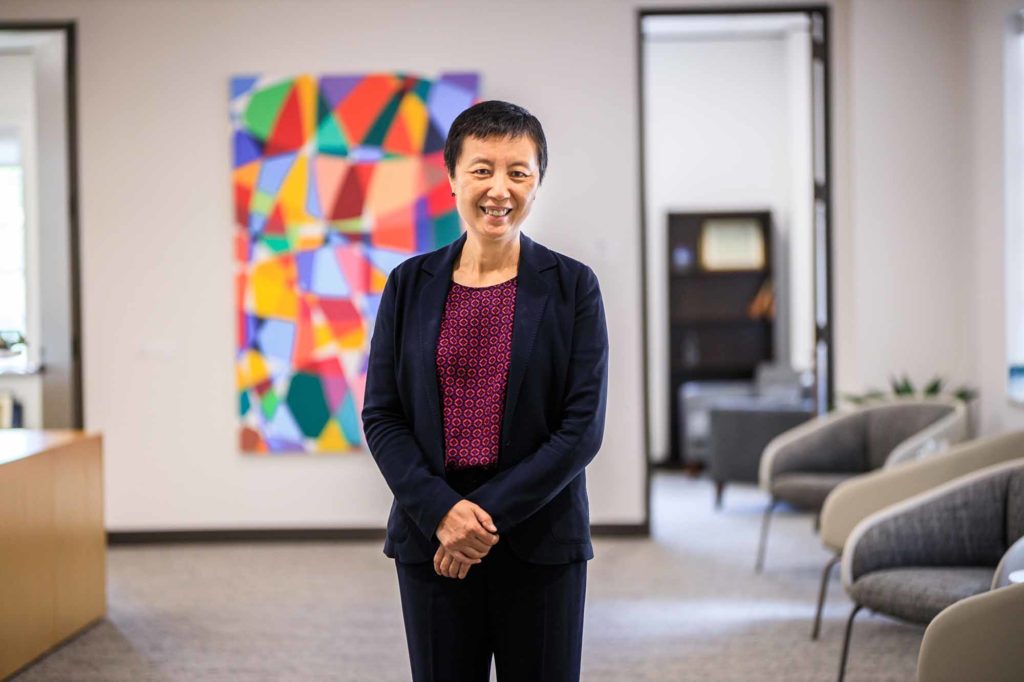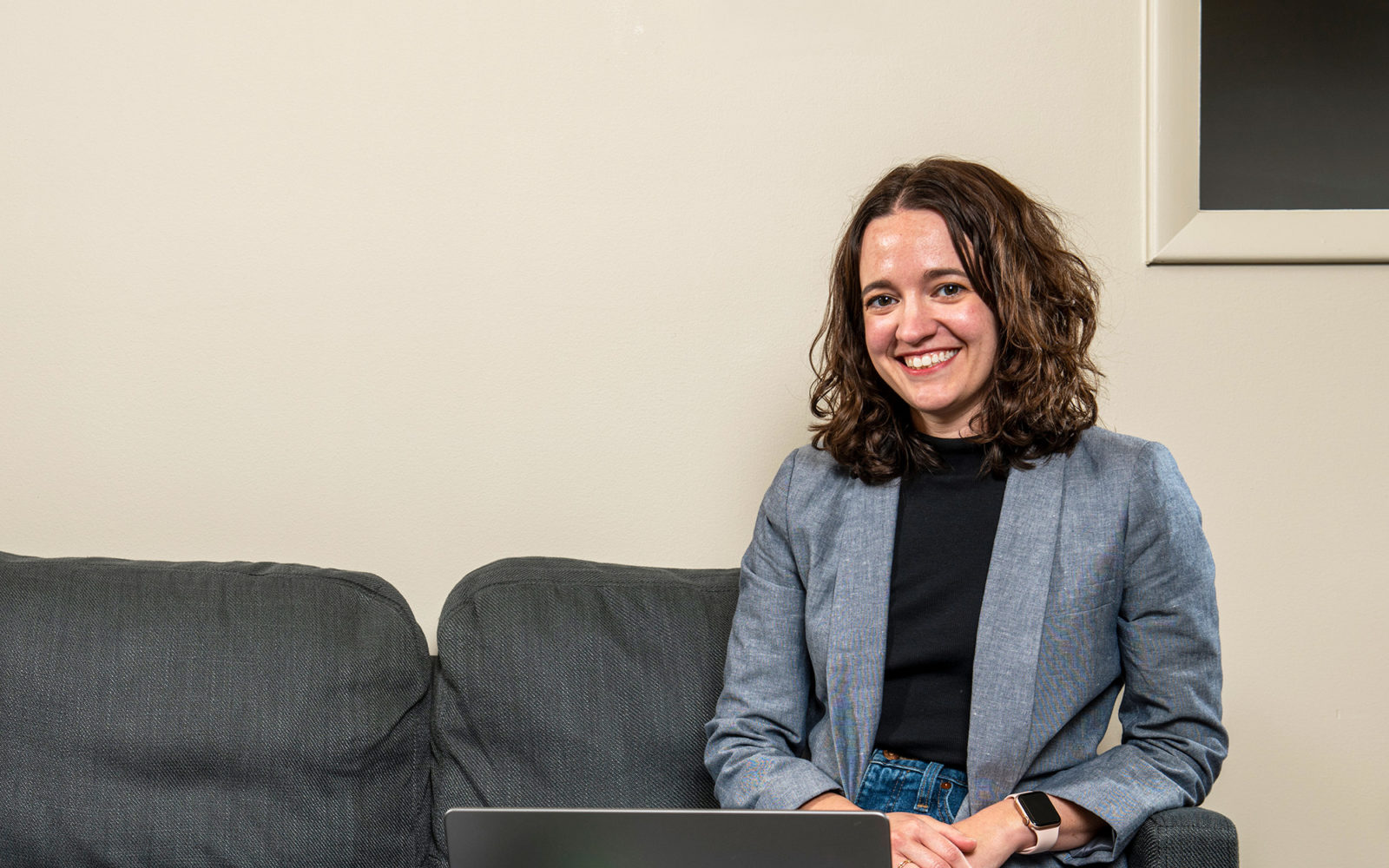First Person
Back Page: Creativity Research and the Power of Problem Identification

APS Fellow Jing Zhou is the Mary Gibbs Jones Professor of Management and Deputy Dean of Academic Affairs in the Jesse H. Jones Graduate School of Business at Rice University. Learn more about her work.
What triggered your research interest in organizational behavior and the factors that facilitate or inhibit creativity and innovation?
When I entered the PhD program at the University of Illinois, creativity as a research stream in the broader field of organizational behavior was emerging. My dissertation advisor at that time, Greg Oldham, was starting to do creativity research. I was very intrigued, as I hadn’t even known there was such a thing as creative research in the workplace.
The idea really resonated with me because as a young girl growing up in Beijing, I loved art and drawing—but that was during the time before China embarked on economic reform. People were poor and opportunities were limited. I had no access to any teacher who could teach me how to draw, how to paint. But my urge to draw was so strong that I would go to bookstores and read books to teach myself how. That was not an effective way of learning painting, for sure, but I just could not stop.
Somehow this self-study continued until I entered high school, where I was on the STEM track. The college entrance process in China was incredibly competitive back then; the year I graduated from high school, only 4% of the students who took the college entrance exam were admitted by four-year colleges. Teachers and everybody I knew told me I had to stop drawing and spend all my time focused on studying for the exam. I loved drawing so much that I would literally pretend I was studying chemistry, math, or physics … and when no one was watching, I would take an unfinished drawing out from a drawer under the desk and add a few sketches here and there.
All this is to say that growing up, my creativity was stifled. So when I realized that Greg was doing creativity research in the PhD program, I became intrigued. The more I read and thought about this emergent research stream, the more I became interested, ultimately deciding to do my dissertation on creativity. I am so happy that I made that choice. This is such a fascinating field!
Your research (and that of others) has found that creativity and innovation in any organization are vital to its successful performance. Help us understand that connection.
To make the connection between creativity/innovation and organizational success, it really is important to define creativity first. Creativity refers to the generation of new and useful ideas. The ideas can be about products, services, processes, or business models. Innovation refers to the implementation of creative ideas. The way we define creativity in the field of organizational behavior is different from artistic creativity in the sense that we define creativity as not just new but also useful. Organizations need to come up with new product ideas and improve the services they provide in order to increase their profit margins, delight their customers, do well in the marketplace, and achieve sustainable growth. Internally, creative ideas enable organizations to engage in process improvements, making the work processes more effective and efficient. Such continuous improvements allow employees to get work done well and in a cost-effective and timely manner, contributing to the organization’s bottom line while also realizing personal growth and fulfillment. These are the primary factors linking employee creativity and innovation to overall organizational effectiveness, competitiveness, and success.
However, our research also suggests the relationship between employee creativity and organizational success is not as straightforward as it may appear. In a study published in 2013, my coauthors and I found that whereas some companies’ performance improved as core knowledge workers’ creativity increased, other companies’ performance went down as core knowledge workers’ creativity increased. We reasoned that the latter type of organizations didn’t do a good job capitalizing their workers’ creative ideas and converting them into successful products or services. Overall, our research on creativity and innovation suggests that organizations should not only foster employee creativity but also do a good job recognizing and using creativity—that is, managers need to be trained to evaluate, endorse, and implement employees’ creative ideas. I’ll return to this topic a bit later when I discuss my work on the receiving side of creativity.

Yet there seems to remain a bias against creativity, or at least a discomfort, that extends beyond the workplace itself. For instance, a 2022 study found that investors respond negatively to executives’ discussion of creativity. What accounts for this bias, and what do we know about how to ameliorate it?
Yes, there is a bias against creativity. There is also a tendency to avoid the risky and the unknown—not necessarily an active bias against creativity per se. In general, human beings like to stick to the routine, the tried and true. Creativity by definition is new and unproven, so naturally the average person is reluctant to embrace new things that have not been proven to work. For this reason, people may not eagerly embrace creativity. If an organization introduces a new way of doing things, it can also create discomfort if people see that new way of doing things as intruding into their territory and reducing their control of resources. They feel creativity leads to a loss of their power instead of seeing the big picture—that a new way of doing things might streamline the work process and reduce costs, which are ultimately good for everyone involved.
Research on why people don’t embrace creativity or even hold biases against it is relatively new and ongoing. I am confident that digging deeper into the psychological reasons behind people’s bias against creativity will go a long way toward discovering effective ways to overcome the bias and encourage the average person to embrace creativity.
What have you identified as some of the personal or contextual characteristics that that can enhance—or stifle—employee or team creativity?
One approach is providing positive feedback in an informational style. My work has shown that when managers and coworkers are trained to provide useful feedback, it increases both individual employees’ creativity and teams’ creativity. My coauthors and I have done quite a few projects whose results suggest feedback is a useful tool for promoting creativity.
Another effective means for enhancing creativity in the organizational context is to provide employees with creative role models. Organizations should identify coworkers who are particularly good at generating both new and useful ideas. The untrained employee or the layperson may have the misunderstanding that creativity is anything new, ignoring the need to include usefulness in creative-idea generation. A truly creative idea in the workplace should solve certain problems or satisfy certain customer needs. My work has shown that it’s really important to make sure everybody in the organization is on the same page about what creativity means. When employees work shoulder to shoulder with a creative coworker—a creative role model—during daily interactions, they learn how to identify a problem and come up with different ideas for solving the problem; evaluate, select, and refine their ideas to make them truly useful; and then sell their ideas to others to build coalition and get them implemented. It’s beneficial for employees to observe somebody doing it and learn from that person. My research has found that having creative coworkers will help employees learn how to be creative.
Last but not least, we have consistently found leadership to be instrumental in affecting employee creativity: Certain types of leadership styles foster it, whereas other types constrain it. Thus, if an organization is serious about promoting creativity in their employees, they really need to provide systematic training to their managers.
Much of your research has exposed findings about workplace creativity that sometimes seem counterintuitive—for instance, that it often arises from job dissatisfaction, underemployment, or being in a bad mood. Have these findings surprised you? Why or why not?
This is such a great question! No, we were not surprised to find that bad moods and job dissatisfaction may be good for creativity. We actually theorized and predicted such effects. Upon first glance, some readers may find this surprising if, for instance, they hold the preconceived notion that job satisfaction is good and dissatisfaction is bad. But when we studied the phenomena in the workplace, when we interviewed managers, when we looked at the creativity literature, we found a major gap in our knowledge about the role of job dissatisfaction or bad moods.
For example, managers told us they were puzzled by the role of job satisfaction in creative endeavor. The assumption is that high job satisfaction leads to high performance and low turnover. But both primary studies and meta-analyses didn’t find such a straightforward positive impact of job satisfaction. After extensive reading, talking with people, and thinking about the phenomena, we realized that feeling dissatisfied about some aspect of the job or work process can trigger a search for better ways of doing things. But when we searched the literature, we discovered that little had been done on this topic. Why? One reason is that for a long time, psychological research on creativity was done in the behavioral lab where research participants were given some problems to solve. Few studies included a design in which research participants were asked to decide whether there was a problem to solve or not.
In the workplace, things are different. Problem identification is often the first, and perhaps crucial, step for employee creativity. People who feel dissatisfied in their job have a better chance of identifying the room for improvement than people who experience high levels of job satisfaction. They’re more likely to identify what does not work and hence needs to be improved upon.
When we conducted our studies, there had been sparse work that demonstrated the value of bad moods and job dissatisfaction in starting the creative endeavor. But when we engaged in theoretical analysis, drawing insights from the mood-as-input theory and also a theory on reactions to job dissatisfaction, we were able to make the logical deduction and formulate our hypothesis that an employee’s bad mood and job dissatisfaction could be the starting point for their creativity journey. Indeed, our empirical studies found support for this hypothesis.
What practices or behaviors by managers and leaders have been shown to support these employees’ creative thinking and, ideally, boost their retention of talented staff?
When I was reflecting on what I’ve learned from a systematic program of research on creativity and from discussions with executive MBA students in the classroom, it struck me that the single most important thing that organizations should do if they’re serious about enhancing employees’ creativity and innovation is to provide creativity training to both employees and managers. My observations indicate that without proper creativity training, when they are asked to be creative, employees tend to focus on coming up with ideas, any ideas. It’s relatively easy to just come up with lots of ideas. Yet managers tend to focus on economic benefits because they have profit and loss responsibilities, so their tendency is to reject a lot of the ideas. Once employees submit ideas but get rejected, they’re discouraged and less likely to be proactive in coming up with ideas again.
What I’ve observed both in my research and in my interactions with executive MBA students is that few organizations provide systematic training to help their employees and managers learn how to come up with truly creative ideas. Also, few universities teach students techniques for thinking creatively. Having not been trained on how to think creatively, employees are not likely to come up with high-quality ideas. Yet low-quality ideas put a burden on managers—they need to spend time and mental energy to evaluate them. And if they are not trained in this selection process, they are not likely to do it well. In short, lots of organizations say they desire employee creativity, yet they don’t invest in training managers or employees in how to identify a worthwhile problem to solve and how to come up with good ideas to solve it by bringing knowledge from diverse sources, synthesizing those ideas, and working with others to come up with highly creative ideas. I feel that this is a major piece of the puzzle that’s lacking in organizations today.
You have also researched creativity and leadership in China and Korea. How much variation (or consistency) have you found in attitudes toward creativity across Western and Eastern cultures? Is this shifting?
You’re absolutely right—there has been a shift in the East about creativity and innovation. Noticing the lack of theory-driven cross-national comparisons on workplace creativity and innovation, my coauthors and I developed a theoretical framework on East–West comparison (2010, M&O Review). We also conducted empirical work in Asian countries such as China and Korea, revealing antecedents of workplace creativity and factors that influence creativity recognition and endorsement. Our work suggests that managers and employees in those countries have determined that to be competitive in the marketplace they need to be innovative. This has been a remarkable shift in mindset from the previous emphasis on treating low cost as a competitive advantage. Certainly, it takes time to evolve from a shift in mindset to effective action, especially in cultural contexts where conformity has been emphasized historically (2003, Academy of Management Journal). Short term, this progress has been more incremental than radical (i.e., achieving major breakthroughs). But the increase in innovation efforts has been substantial.
Related content: Evolving From a ‘Knowledge Economy’ to a ‘Creativity Economy’
To maintain their competitive advantage and address environmental and societal challenges, in Western countries such as the United States, organizations in a variety of industries must increase their investment in creativity training and enhance their internal capabilities for sustainable innovation. At the society level, the West needs to truly invest in education, helping students to internalize an innovative mindset and acquire creative problem-solving knowledge and skills.
Where do you see your research going next, and how else could psychological science contribute to organizational success in the years ahead?
Working with collaborators, I’ve built a systematic research program centering on creativity and innovation. I continue to be very excited about expanding this research program. My future research will advance along two directions. One is the receiving side of creativity. My coauthors and I published an article in the Journal of Applied Psychology in 2017 looking at how different individuals under different contexts recognize novelty and creativity. We also published a major piece on the receiving side of creativity in the Journal of Management in 2019. On the basis of a multi-disciplinary review, we developed a framework that we hope will guide future research on this area of study. We also have a paper forthcoming in the Journal of Management on how receivers’ power influences the endorsement of creative ideas. I am very optimistic about this new research direction.
I am also excited about continuing my program of research on the antecedents of creativity. This work has generated insights for organizations to devise interventions to promote employee creativity and foster both the generation and implementation of ideas.
In both research directions, cross-national comparisons will add value to knowledge creation.
I continue to see the field of creativity as a rich research area that is full of potential for interesting discoveries. I’m very excited to continue to do research in this area. Psychological science plays a key role in all my work, as theories and previous research in the field helped me formulate theories for understanding the receiving side of creativity and predicting how personal and contextual factors affect creativity in the organizational context. These theories reveal the mechanisms through which leaders and managers can design interventions to promote employee creativity and the psychological reasons behind why some factors promote versus others restrict employee creativity. Likewise, my newer work on the receiving side of creativity has also benefited tremendously from psychological science in terms of insights into why, for the same creative ideas, different people and under different contextual influences recognize, evaluate, and endorse creativity to different extents.
Fundamentally, creativity and innovation are human behavior, and understanding psychological mechanisms helps to predict and change behavior. To a degree, psychological science has been the disciplinary foundation for my work. I am very grateful for how psychological science collectively has not just informed my research but—of greater importance—has informed organizations and managers on how to promote employees’ creative-idea generation, recognition, and implementation.
Back Page showcases particularly interesting work by a wide variety of psychological scientists. Know of a good candidate for a future profile? Contact the Observer at [email protected].
Related content we think you’ll enjoy
-

Burnout and the Brain
Burnout is not just a state of mind. Psychological research shows it to be a condition that leads to distinctive changes in the anatomy and functioning of the brain.
-

Can Scientific Rigor and Creativity Coexist?
Will heightened standards for rigor and transparency quash the kind of inventive theories and predictions that have driven psychological science in the first place?
-

Careers Up Close: Amy Belfi on Music Perception and Cognition
Amy Belfi, an assistant professor at Missouri S&T, discusses her research into the impact that audio and music have on the brain—and looking forward to learning more, getting tenure, and playing the upcoming Nintendo Zelda game.
Feedback on this article? Email [email protected] or login to comment.





APS regularly opens certain online articles for discussion on our website. Effective February 2021, you must be a logged-in APS member to post comments. By posting a comment, you agree to our Community Guidelines and the display of your profile information, including your name and affiliation. Any opinions, findings, conclusions, or recommendations present in article comments are those of the writers and do not necessarily reflect the views of APS or the article’s author. For more information, please see our Community Guidelines.
Please login with your APS account to comment.